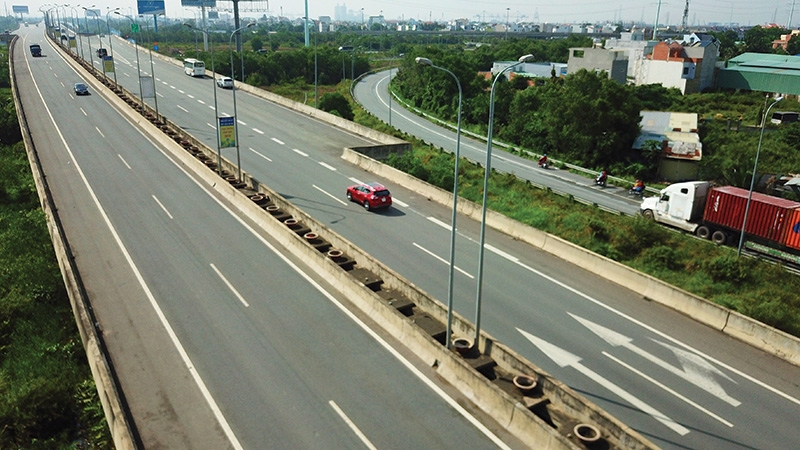Looking further afield to stimulate infrastructure
 |
| Vietnam can take lessons from other jurisdictions when it comes to creating efficient PPP regulations, Photo: Le Toan |
Vietnam is one of the world’s fastest-growing economies. With over 96 million people and an average annual GDP growth of 6.3 per cent over the past decade, the country’s demand for infrastructure projects has skyrocketed. Vietnamese leaders have been concluding free trade and investment protection agreements with nations across the globe, and most recently with the European Union, increasing the ease with which foreign investors are able to involve themselves in Vietnamese infrastructure projects.
 |
| Huyen Pham |
In the first half of 2018, Vietnam for the first time joined the top five countries in the world for overseas investment in infrastructure projects. From 2010 to 2018, the country saw around $12.5 billion in foreign funds poured into infrastructure, with over $6 billion invested in 2017 and 2018 alone. Aiming to attract overseas capital and serve the interests of the Vietnamese people, the Ministry of Planning and Investment recently released the draft of a new law on public-private partnership (PPP), due to be passed next year.
Building on previous government decrees from 2015 and 2018, the proposed draft law creates a national fund to ensure project viability, offers an enhanced risk-sharing mechanism in the form of government guarantees, and empowers investors to finance their projects through Vietnam’s developing capital market.
This new approach to PPP mirrors frameworks and solutions implemented abroad. Indeed, the draft even makes explicit reference to the laws and experiences of at least eight foreign jurisdictions, as well as to recommendations from the UN Committee on International Trade Law.
Though the law has not yet reached its final form, the anticipated changes to Vietnam’s project finance regime stand to improve the country’s appeal as a destination for infrastructure investment, to the benefit of investors and Vietnamese citizens alike. Moreover, in observing the legal structures that other countries have used to nurture PPP, Vietnam will enhance its ability to avoid the pitfalls experienced elsewhere.
VIABILITY GAP FUNDING
In 2015, the Vietnamese government introduced an improved structure for viability gap funding in PPP. Decree No.15/2015/ND-CP offered state support in the form of a capital contribution financing a project’s undertaking or as a payment to the investors under build-transfer-lease and build-lease-transfer contracts, among others. These provisions were repeated in Decree No.63/2018/ND-CP dated May 2018 on PPP investment, and also feature in the draft law.
That said, the new legislation goes a step further in ensuring a project’s viability for investors with the establishment of a national PPP project development fund and counterparts at the local level. These PPP funds are intended to assist with financing projects from start to finish, providing increased resources for investment preparation, construction and land development, as well as government guarantees.
Comparable funds have featured in the legal frameworks for PPP implemented in Japan, South Korea, and Brazil, among others. Following a 2013 revision of its Private Finance Initiative Act, Japan created the Private Finance Initiative Promotion Corporation of Japan (PFIJ), whose role is to provide risk money for projects in which sponsors bear the demand risk. To that end, the PFIJ has sought to grow infrastructure investment by providing investors with increased certainty as to their returns while reducing Japan’s national deficit by focusing on user-pay projects.
South Korea’s Infrastructure Credit Guarantee Fund was established in 1994, focusing exclusively on the provision of credit guarantees. Similarly, the Brazilian Fundo Garantidor de Parcerias Público-Privadas (FGP) was also set up to honour government obligations under PPP contracts. The FGP’s achievements, however, have been allegedly more lacklustre than those of its Japanese and South Korean counterparts. In effect, the fund received only one application between 2004 (its inaugural year) and 2016. This has been due to the local guarantee funds that had already been established by a number of state governments.
Despite the dual local-national scheme envisaged, Vietnam eschews Brazil’s disjointed structure by creating certain categorisations that confine projects either to the national or local funds. Moreover, only the national fund is permitted to issue government guarantees, a limit which might further prevent such issues from being engendered.
Still, the specifics as to the guarantees for which the national fund will be responsible remain to be determined in future government decrees after the passage of the draft law. Once further elaboration is provided, resemblance to the Japanese or South Korean models will be more easily ascertained as will the true extent of Vietnam’s viability gap funding reform.
MINIMUM REVENUE GUARANTEES
One of the most significant changes to PPP-financing proposed in the draft law is the availability of minimum revenue guarantees (MRGs) for project investors. Under the new provisions, the state could guarantee up to 75 per cent of expected revenue for the first five years of the project’s life, and up to 65 per cent for a second five-year period. In exchange for such guarantees, the state would require the return of all income over 125 per cent of expected revenue for the first five years and all income over 135 per cent for the following five years.
For revenue-funded infrastructure projects, this is a major addition to Vietnam’s PPP framework as previous legislation had been light on risk-sharing mechanisms. MRGs have been used in a number of countries, notably South Korea, Chile, and Indonesia as a tool to increase a given project’s attractiveness to potential sponsors as they mitigate demand and revenue risks outside the project company’s control.
Though the South Korean government eliminated its MRG provisions in the wake of the 2008 financial crisis, Chile’s use of such guarantees in transportation infrastructure was more successful. In effect, Chile realised its aims of encouraging private investment without excessive expense for the government, even as the country weathered an economic crisis from 1998 until 2002.
A study on Indonesian build-operate-transfer infrastructure projects, furthermore, has shown that MRGs are a more effective means for mitigating a sponsor’s financial risks than direct government subsidies. Ultimately, the MRGs proposed in the draft law represent a positive shift in risk allocation for PPP projects. Potential project sponsors will benefit from increased certainty while the country will, in turn, benefit from increased investment in infrastructure development.
BOND ISSUANCE
Basing itself on the South Korean model for PPP financing, the draft law explicitly affirms a project sponsor and project company’s ability to issue bonds in order to secure funding for the venture, a provision absent from previous PPP decrees. This change is in line with the growing role for capital markets in Vietnam and an incremental shift towards capital markets to better ensure sustainable economic development.
Though the draft law specifically refers to the Korean Act on Public-Private Partnerships in Infrastructure, the use of bond-financing is featured in the project finance frameworks of several countries including Belgium, Canada, Australia, the United Kingdom, and the United States. As the debt capital market in Vietnam develops further, sponsors can expect to reap the benefits traditionally associated with financing PPP by issuing bonds. Longer maturities, increased flexibility for financial covenants, and a larger pool of investors stand to make certain projects more economically feasible in the long run.
The National Assembly has yet to pass the Law on Public-Private Partnership. Moreover, even once passed the law must be further clarified and interpreted. All the same, there is good reason for enthusiasm as the draft legislation represents a promising reform of Vietnam’s environment for PPP.
Though not all issues presently discouraging private investment have been resolved, the draft law’s provisions on viability gap funding, risk-sharing, and project financing are all laudable improvements. With its rapid economic growth, a strengthened legal framework, and an ever-increasing demand for infrastructure investment, Vietnam is poised to become a top destination for foreign capital.
What the stars mean:
★ Poor ★ ★ Promising ★★★ Good ★★★★ Very good ★★★★★ Exceptional
 Tag:
Tag:
Themes: EVFTA & EVIPA
Related Contents
Latest News
More News
- Government moves to establish International Financial Centre (December 21, 2025 | 21:00)
- Vietnam's IFC to target global investment flows (December 21, 2025 | 18:00)
- Two national hospitals expand capacity with new facilities (December 20, 2025 | 09:00)
- Ha Tinh breaks ground on major Vingroup industrial and energy projects (December 19, 2025 | 18:24)
- EVN launches major power infrastructure projects nationwide (December 19, 2025 | 18:17)
- VAL inaugurates second production line to meet domestic animal feed demand (December 19, 2025 | 16:37)
- Sun Group pioneers urban tram system in Phu Quoc (December 19, 2025 | 15:00)
- Seven major projects launched to drive Hanoi’s next growth phase (December 19, 2025 | 14:00)
- Securing capital and efficiency for Vietnam’s 2026-2030 growth ambitions (December 17, 2025 | 10:00)
- Vietnam bucking trend in the global M&A landscape (December 16, 2025 | 14:20)






















 Mobile Version
Mobile Version